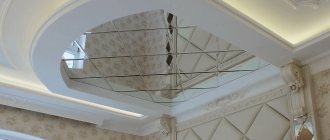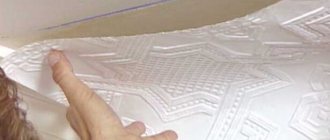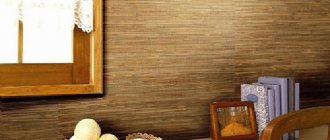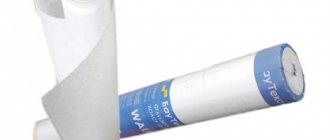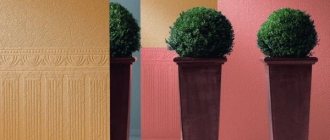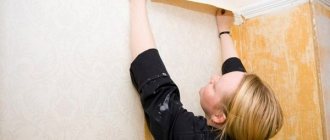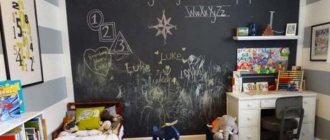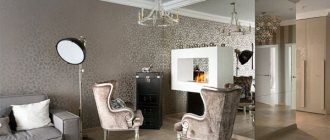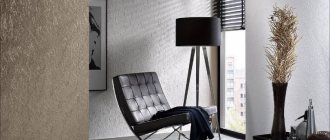Many interior styles include a textured pattern on the ceiling. The texture can be made using putty, but this process is very expensive and time-consuming. The ideal solution would be to use ceiling non-woven wallpaper or fiberglass wallpaper, which is subsequently painted in the color desired for the design. Such textured wallpaper is also called Matting.
In this article we will look at how to paint wallpaper for painting on the ceiling, what tools are needed for this, how to choose paint and prepare the room for work.
Types and advantages of wallpaper for painting
The advantages of finishing ceilings with these materials include:
- easy gluing. During the work, you will not have to carefully join adjacent canvases, unless they have a clear pattern that requires matching the contours;
- wide selection of textures and shades. For painting, choose paint colors that match the interior. You can express the decor and visually delimit the space by combining two shades on one surface.
When it comes to textures, there are also endless possibilities. Stores offer canvases with three-dimensional patterns or smooth surfaces;
- They also sell special wallpaper - moisture-resistant and washable. They are used for finishing kitchen ceilings;
- using wallpaper you can disguise small flaws and cracks on the ceiling;
- Some types of canvas can withstand repeated repainting.
As for the disadvantages, there are also disadvantages. For example, the service life of such finishing does not exceed five years. During operation, painted canvases may lag behind the ceiling, so you have to glue them.
Relief pattern of wallpaper for painting photo
Wallpaper for ceilings for painting is available in several types:
- paper Pasting the ceiling surface with paper wallpaper is similar to finishing the walls. The required piece of canvas is cut from the roll, coated with glue, then carefully applied to the base;
- Paintable glass wallpaper is made from fiberglass threads. The result is a beautiful coating with an original relief. Compared to paper glass wallpapers, they are durable and easy to care for. As for the disadvantages, the only disadvantage of this type is the high cost;
- non-woven. Gluing the canvases is easy and quick; only the surface of the ceiling is coated with the adhesive. The advantage is that the canvas can be repainted several times.
An alternative could be photo wallpaper for the ceiling - tips for choosing, correct gluing.
Getting ready to paint
The cornices are puttied with fine-grained putty, using only rubber spatulas. Sometimes they do without them, doing everything by hand - it’s too much work. If you don’t have putty on hand, silicone sealant will do (white, colorless, it doesn’t matter).
The composition is applied from top to bottom onto the joints, applying slight pressure. This will allow the material to penetrate into all the depressions and crevices, but avoid deformation of the material. By the way, when you work with your fingers and not with a spatula, it is much easier to repeat the relief.
Don't forget to wear rubber gloves - they will protect the skin of your hands.
It is convenient to remove all excess substances with a sponge previously soaked in water and wrung out. We seal the joints in the corner, as well as the gaps between the baguettes and the ceiling, in the same way.
After the putty has dried, go over it with a primer to get rid of various kinds of dust particles that affect the final result. Don't forget to cover the floor - for example, with newspapers. To protect walls from paint, you can use special masking tape.
Paint selection
Before you begin the repair, you need to know how to paint the wallpaper, since the durability of the finish and the appearance of the coating will depend on the correct choice of the coloring composition. Acrylic and water-based paints are most often used. Latex-based paint adheres well to various surfaces. But it has a drawback - it dries out quickly. Therefore, the composition is diluted in small quantities to be worked out at a time.
Latex paint for painting wallpaper
It is better to paint vinyl sheets with acrylic paints; for glass wallpaper, both acrylic or water-based emulsion and alkyd compounds are used, which will create a hard film on the finishing surface with a long service life.
Acrylic paint for wallpaper on the ceiling
The choice of paint is influenced by the texture of the material. Matte compositions are more often used for painting textured canvases with a rough surface. They are not moisture resistant and do not like wet cleaning, so it is better to use such wallpaper for finishing rooms with low humidity levels.
Glossy paints are characterized by increased resistance and durability. With their help, you can visually expand the boundaries of the room.
Useful tips
When painting wallpaper on the ceiling, you must adhere to some rules:
- It is advisable to choose plain wallpaper so that when you subsequently repaint from one tone to another, color distortion does not occur.
- To paint non-woven finishing material, it is prohibited to use oil-based compounds or solvent-based dyes, because they can damage the structure of the wallpaper.
- If the surface of the wallpaper is embossed, you should apply the paint with a large brush with stiff bristles, since this way the paint will lie more evenly.
- When applying water-based emulsion to ceiling wallpaper, you need to roll it out in a strip the width of the roller from wall to wall, and then roll out the next strip of paint next to it, trying not to overlap too much with the previous strip. You can conditionally divide the ceiling into equal small sections and paint them one at a time.
- For textured wallpaper, it is recommended to use a roller with a pile length greater than the thickness of the embossing. For textured matting or non-woven wallpaper with an embossed pattern, you must use a fur coat with medium-length pile. For wallpaper with a fine texture, a fine-pile tool is suitable.
- It is recommended to work with a roller while standing on the floor, using a telescopic handle. In this position it is better to control the uniformity of paint application. When painting with a brush, it is better to use a stepladder.
- After painting 2-3 layers, you need to wait for the wallpaper to dry completely. This may take from 1 to 3 days.
- Do not turn on the air conditioner or fan to speed up the drying of paint.
If you want to remove wallpaper from the ceiling and paint it, after removing the finishing material, you must prime the surface, putty with a thin layer, and then grout the ceiling to eliminate unevenness.
Thus, you can cope with painting a ceiling covered with wallpaper yourself. But to obtain a high-quality result, you must follow the rules and sequence of painting work.
How to paint wallpaper on ceilings
A blue background on the ceiling will add volume to the room.
Painting work begins from the corners of the room. The brush is moistened with paint, and excess composition is removed on the edges of the container. Using gentle movements in one direction, apply paint to the ceiling surface around the perimeter.
Painting is carried out in two layers. The next layer is applied after the previous one has completely dried. In this case, the ceiling is covered with the first layer along the wall on which the window opening is located, and the second is applied in a direction perpendicular to the first.
The algorithm of actions will be as follows:
- pour a small amount of paint into the tray;
- dip the roller in the composition, roll the tool over a smooth surface to remove excess paint;
- Apply the composition evenly onto the ceiling using a roller.
On a note! To avoid thickening of the paint layer in individual areas, work quickly with the roller and cover the ceiling with paint at one time. If part of the ceiling surface has time to dry, then when painting the adjacent area, a visible transition will form.
If you need to give the ceiling the required shade, add a suitable color to the paint container and mix the composition using a construction mixer.
Painting non-woven wallpaper
Before you start painting non-woven wallpaper, you need to prepare in advance the materials and equipment necessary for the work:
- coloring composition;
- paint tray;
- roller with a pile length of 12 mm;
- telescopic handle;
- brush width from 50 to 80 mm;
- polyethylene to protect the room;
- work clothes.
The roller must be selected according to the type of finishing material. For embossed wallpaper, a tool with a long pile is suitable, and for smooth wallpaper, a tool with a short one.
After preparing everything you need, you can start painting. Process sequence:
- Initially, you need to pour the paint into a special tray, dilute it 1/3 with water, and then put the paint on a roller and roll it out on the grooved surface of the tray provided for this purpose. This is necessary to remove excess paint and distribute it evenly over the roller.
- After applying the base layer, you need to use a brush to paint the surface in hard-to-reach places and around the entire perimeter of the room.
- You should wait until the base layer has completely dried, and then apply the final adjustment layer parallel to the window. It is necessary to even out the base tone and mask painting errors when applying the base layer.
Water-based compositions begin to dry 5 minutes after they are applied to the surface. If poorly painted areas are found, they are covered with a correction layer, but this is done only on a dry basis. When gluing new wallpaper to the floor, you need to wait until it is completely dry and only then start painting.
Non-woven wallpaper for ceilings for painting
Non-woven wallpaper of different textures for the ceiling for painting photo
They are made on a paper-fabric basis using the pressing method. Thanks to the special compounds with which the fibers of the material are impregnated, after drying the fabrics do not wrinkle or stretch.
Such wallpapers have the following advantages:
- mask minor irregularities;
- hide cracks and prevent their further divergence;
- strength and density.
Wallpaper work with non-woven fabrics is carried out carefully, since the loose surface of the material is easy to damage with a sharp object. Non-woven wallpaper is painted immediately after gluing it to the ceiling. A coat of paint will strengthen the finish and add durability.
Use a sponge to remove air from under the wallpaper
Non-woven fabrics are easy to stick on. Glue is applied only to the ceiling. Each subsequent strip is applied end-to-end to the previous one and smoothed using a rubber roller or spatula. Excess glue is immediately removed with a sponge. Strips of the required length are measured and cut in advance, or cut off during operation.
How to hang wallpaper on the ceiling: a step-by-step guide.
As for coloring non-woven wallpaper, there are several options:
- canvases with embossed surfaces can be painted with latex paints even before they are glued to the ceiling on the reverse side. An interesting effect will be obtained: the base will acquire the declared shade, and the relief areas will remain white;
- if non-woven wallpaper is already glued to the ceiling, use water-based paint. The result can be obtained as in the first method. To do this, the composition is diluted with water, and upon completion of painting, the paint is removed from the convex elements with a clean sponge. After the paint has dried, the relief structure is painted in a color that matches the interior;
- when it is necessary to give the ceiling surface a delicate pastel shade, the canvases themselves are not painted, but the surface to which they will be glued is painted in a bright tone. Since non-woven wallpaper is translucent, the paint will show through its structure, and the combination of white and bright will give a pastel color.
Preparatory work
Before you paint the wallpaper on the ceiling with water-based paint, you need to do some preparatory work. These include the following:
- De-energizing the electrical wiring in the room where painting will be done. This will prevent electric shock or short circuit.
- Bringing the room temperature to the values recommended by the paint manufacturer.
- Preventing drafts, since it does not allow the paint composition to dry evenly, and there is also a risk of dust settling on the undried surface.
- Covering floors, doors, windows, lamps with polyethylene, as well as removing furniture from the premises.
- Prepare gloves, safety glasses, headgear and tools required for the job.
When performing complex repairs, the ceiling is painted before the walls are finished, so it is not necessary to protect them. When repainting only the ceiling, the walls must be covered with plastic film, secured with double-sided tape.
How to paint wallpaper on ceilings without staining the walls
We beat off the outline with a brush
To avoid spoiling the appearance of the walls when painting the ceiling, use a paint masker. It consists of a protective polyethylene film with adhesive tape along the length of the canvas. Glue the tape at the junction of the wall and the ceiling surface, and spread the film along the wall. The advantage of Masker is that there will be no traces left after its use. Therefore, you can attach the tape to any surface.
To paint wallpaper on the ceiling for painting, use a roller with reinforced bristles. Thanks to the interweaving of synthetic fibers with metal threads, the pile of the tool does not deform during the painting process, and the paint does not splash and lies flat.
Which roller is better to paint the ceiling: choose the appropriate option.
Along the perimeter of the ceiling surface, where the wall touches the ceiling, paint the wallpaper with a brush. To avoid staining the walls, place a wide spatula between the wall and the painting tool, moving it as you paint.
Advantages
Among the advantages of wallpaper for painting:
- have a dense structure;
- ideal for those who love painted walls;
- you can repaint the ceiling at low cost;
- comparatively cheaper than other types of wallpaper;
- hide imperfections and cracks in ceilings;
- amenable to repeated staining;
- allow you to create the desired shade;
- represent the ideal space for imagination: coloring, decor, painting.
Look at the photo to see how ceiling wallpaper looks in the interior.
Wallpaper on the ceiling for painting with water-based paint
Apply the second layer of paint.
The water-based emulsion is diluted with water until the desired consistency is obtained, mixed with a construction mixer. Manufacturers usually advise adding water in an amount of 5-10% per paint container.
First, use a brush to paint the perimeter of the ceiling with a slight indentation from the walls so as not to stain the finish. Next they move on to working with the roller. The ceiling is painted with the first layer along the wall with windows, the second - perpendicular to the first.
Highlight the relief on the wallpaper with a different color
The optimal number of layers of paint is two. But, if you want to visually highlight the surface relief of the decorative coating, apply a third layer of the composition using a rubber or velor roller.
The advantage of finishing ceilings with wallpaper for painting is associated with the ability to choose the decor and color that will match the interior, while you can handle the painting yourself. The main thing is to choose the right materials, maintain consistency and accuracy in work.
You might be interested in how to putty a ceiling for painting and wallpaper.
Wallpaper on drywall
I took a regular pencil for drawing on whatman paper and marked a vertical line near the door using a laser level. You can take a simple plumb line. Then I marked the horizontal upper border with a thin line. We unrolled the wallpaper and carefully studied the drawing. It was necessary to cut so that the lines coincided at the joints.
- We counted the number of whole stripes on each wall. Cut with an allowance according to the design, but not less than 5 cm.
- We coated the drywall with glue, about a meter wide area.
- We aligned the side edge and top of the wallpaper strip according to the markings and glued it, carefully smoothing it with a clean roller and rubber spatula, expelling the air.
Wallpaper on drywall
While I was adjusting and gluing a strip of wallpaper, Kirill was applying glue to the drywall for the next one. Over the course of the evening, the two of us quickly hung wallpaper on drywall in a large room. The next room took longer to cover. Kirill inquired in advance about how to glue heavy vinyl wallpaper onto drywall. A special glue is selected and applied to the wall and strip of wallpaper. Let it sit for about 5 minutes and only after that the wallpaper is glued to the wall. Vinyl is heavy, so the strip must be held and smoothed until the glue sets, 15 minutes.
Therefore, while I was working on one strip, Kirill was applying glue to the next one and the wall. It took a lot of time. It took a long time to glue the trim. An arch separated the kitchen from the living room. It was necessary to putty in 3 layers, so that moisture resistance would be ensured in the future; a starting cement composition with the addition of polymer additives was used. For the second and third layers, we used a ready-made composition of moisture-resistant putties for damp rooms, a base of gypsum and cement. The composition we need is freely available in the store and there is a large selection from different manufacturers. We calculated how much we need based on the area and thickness of the layer.
We marked and first glued the bamboo bottom - panels. There was a wooden floor in the living room, and a self-leveling, moisture-resistant floor in the kitchen. Kirill already had experience working with bamboo panels. We made a dacha with him, a bungalow-style interior. Above the panels, gluing glass wallpaper did not take much time. Fiberglass adheres well and does not shrink or warp. When we finished gluing, we waited for a week so that the adhesives were completely dry and the walls were painted properly. Now for cleaning you can use any chlorine-free washing powder for walls and floors and quickly get it clean.
Main characteristics of water-dispersion paints
The paint is based on a certain type of polymer. To choose the optimal dye, you need to know its composition, characteristics and scope of application.
- A regular water-based emulsion is the simplest and cheapest option. But for rooms with high humidity, water-based paint should not be used, since it has low moisture resistance.
- Acrylic is a type of latex. The main substance of this dye is acrylic resins. Water-dispersion coatings based on acrylic composites are the most resistant to dry abrasion. After drying, the composition forms a reliable coating, the surface of which can be washed with a damp sponge. Colors retain their original brightness throughout use. But for rooms with high humidity it is better not to use acrylic paint.
- Acrylic-latex (with the addition of butadiene styrene) has a wide range of applications due to its low degree of vapor permeability. Can be applied to wallpaper in damp areas. Its cost is quite high.
- Latex (butadiene styrene) paint is highly resistant to moisture and mechanical damage. But at the same time it is quite sensitive to ultraviolet radiation. It is advisable to use it for painting rooms with high humidity that require regular washing of walls, for example, kitchens and bathrooms.
Advice
The optimal paint for non-woven wallpaper is acrylic. But it can only be used in living rooms with normal humidity. For bathrooms and kitchens, it is more advisable to use latex dyes.
In addition, interior paints come in shiny and matte finishes. When choosing, you need to decide on this criterion.
Interior paint can be of several types.
- Glossy. Suitable for dimly lit rooms. May cause discomfort in well-lit rooms. Has the property of highlighting surface defects. Rarely used in residential premises.
- Semi-gloss. Thanks to its reflective properties, it makes the room brighter. It is good to paint wallpaper in children's rooms and kitchens.
- Semi-matte. Looks good on bedroom walls. Thanks to its gloss, it smooths out small defects.
- Matte. Masks minor surface irregularities. Suitable for large rooms.
- Satin. Abrasion resistant, durable. Gives a nice smooth finish.
What products can be used
Ceilings for painting, photo
Wallpapering and painting ceilings is quite a labor-intensive task, since you have to work in an uncomfortable position, raising your arms above your head. But nevertheless, it is worth it, because the ceiling acquires a beautiful relief and can change color many times without the need to first putty the surface. This finish has other advantages.
This:
- The relatively low price of the material, because 1-2 rolls of wallpaper may be enough for a small room;
- Although wallpaper for painting is most often sold in white, there are other options that do not need to be painted during the initial installation. Painting is done after a few years, when the previous color gets boring, or the wallpaper simply gets dirty (fade);
Colored wallpaper that can be painted later
- A huge selection of textures, allowing the coating to imitate ceiling tiles, leather, or decorative plaster;
- A minimum number of tools are required for gluing and painting;
- Everything is done with your own hands without the involvement of professional specialists;
- The height of the room does not change (in comparison with suspended structures). And by the way, a plasterboard ceiling can also be covered with such wallpaper, which is what we see in the photo below.
How to paint: thanks to its texture, the coating can also be mistaken for decorative plaster
Advice! Ceiling wallpaper is distinguished by the absence of multi-color patterns and the relief of the coating. They have become more popular lately, so they are within an affordable price range for most people.
There are many varieties, but three types are used for painting.
Paper
Paper wallpaper with leather texture, photo
Suitable for any surface - even one that has not been leveled. As a rule, paper wallpaper is two-layer, the same as duplex, but its thickness and density are greater. They are impregnated with special water-repellent compounds, so even after several stains they will not lose their water resistance.
Coarse fiber wallpaper has become a new variety. The relief is obtained not by embossing, but by placing wood chips (waste from woodworking production) between layers.
Large or fine surface texture is determined by the size of the “sawdust”. They cover not only the ceiling, but also the walls, resulting in the feeling of a completely seamless, almost uniform surface.
They stick on very quickly - they don’t have a specific pattern, so you don’t have to worry about adjusting the edges:
- Glue is applied to the strip;
- The sheet is applied to the ceiling surface;
- Pressed down with a roller;
- The edging is cut with a knife;
- The following sheets are glued end to end;
- The areas of application are cut with a regular knife;
- The paint is applied with a special paint roller.
Non-woven
Fine relief on non-woven covering, photo.
Non-woven fabric is a fabric made from pressed pieces of fiber. The fiber is very dense in structure. Foamed vinyl is sprayed onto the interlining through a patterned stencil, resulting in various reliefs. The reverse side remains completely smooth and even.
- Paintable wallpaper with a non-woven base has excellent masking properties: smoothing out unevenness, hiding cracks in the ceiling without leaving a trace. That is, before gluing wallpaper for painting on the ceiling, you do not need to putty the surface.
- During installation, the glue must be applied to the ceiling, and not to the canvas, which will allow the strips to be adjusted to each other extremely accurately. The non-woven base will level and strengthen the surface texture.
- Experts recommend gluing non-woven wallpaper in new homes due to their strength.
- Floors in new buildings often shrink, but non-woven wallpaper will not only not tear, but will also hold the crack, preventing it from going further.
The main thing is that the coating is beautiful - and the mechanical strength of the ceiling is not important. Photo
They have a serious drawback - foamed vinyl (relief) can be easily scraped off even with fingernails. Such wallpaper should be painted when the top layer is stronger.
Fiberglass wallpapers are distinguished by unusually beautiful three-dimensional patterns
They are formed from fiberglass threads produced from soda, lime, dolomite and quartz sand. This coating is combined with a special paper base during manufacturing.
Gorgeous texture of glass wallpaper
Fiberglass wallpaper can be of different structures and densities, with beautiful ornaments, reliefs, and textures:
- They have many valuable qualities, including the ability to correct small irregularities and high fire safety (for this, the material is treated with a special impregnation).
- Fiberglass wallpaper can be embossed or smooth, and the interweaving of threads forms various patterns and textures.
- Before gluing sheets to the ceiling surface, it is recommended to cover it with latex primer in neutral shades.
- The canvases are attached with a special adhesive composition, after which they can only be painted with water-dispersion paints (acrylic or latex).
- Before painting fiberglass ceiling wallpaper, applying primer is no longer required. And this is the only option that can be repainted up to 7-8 times.
- The main advantage of fiberglass wallpaper is durability and solid strength (they can withstand systematic cleaning of the surface with a brush).
Due to their wear resistance and strength, they can be used not only in the living room, but also in hotels, office premises and other public places.
